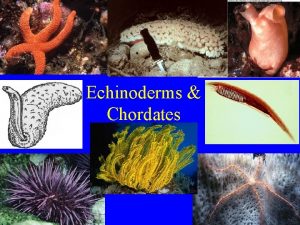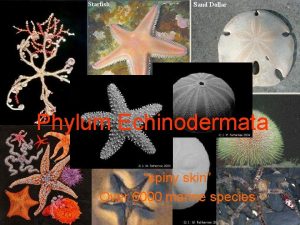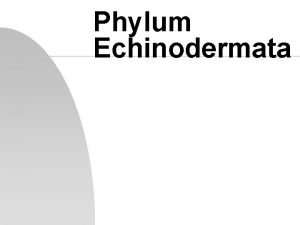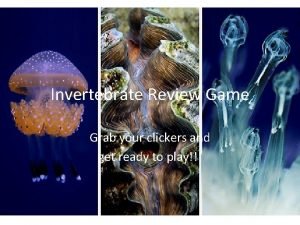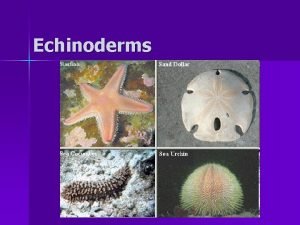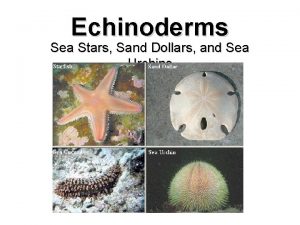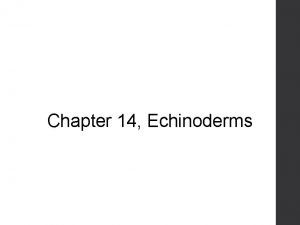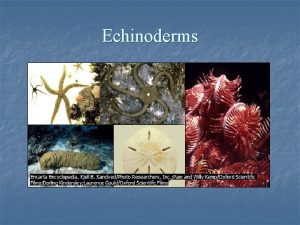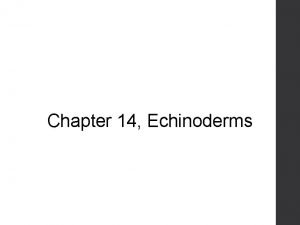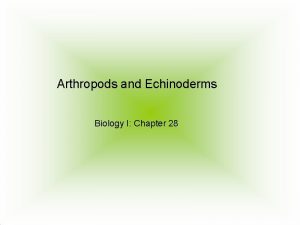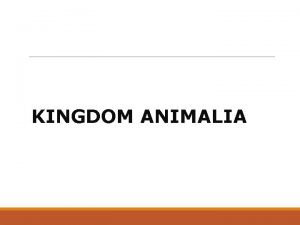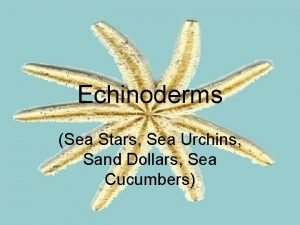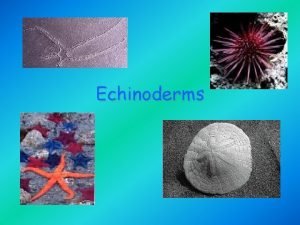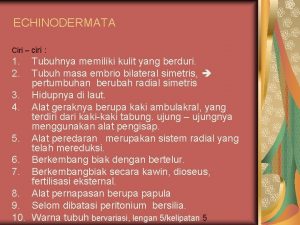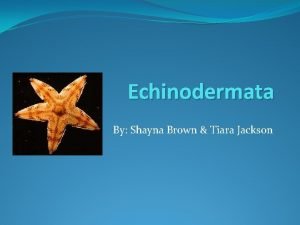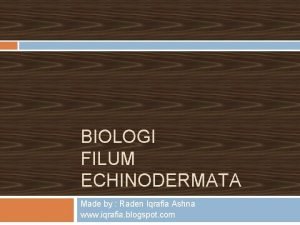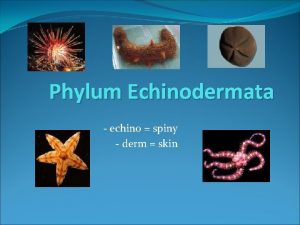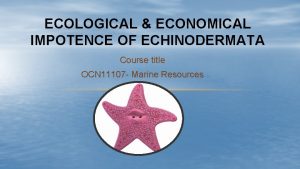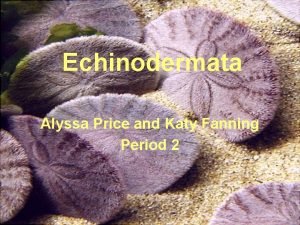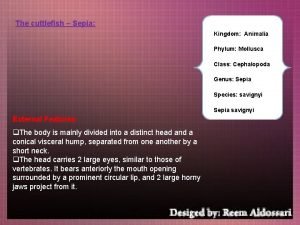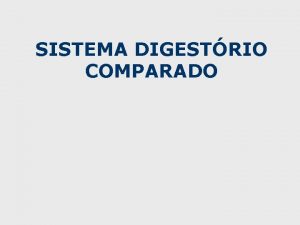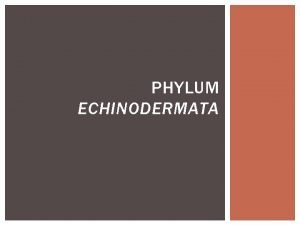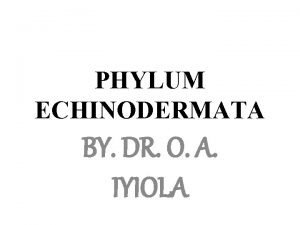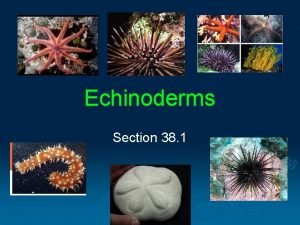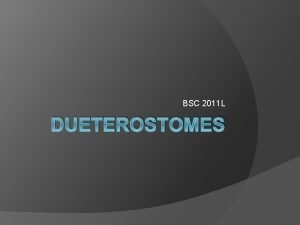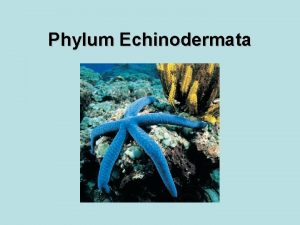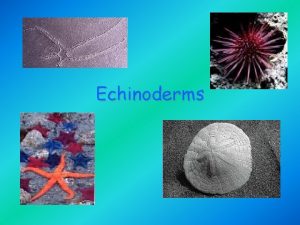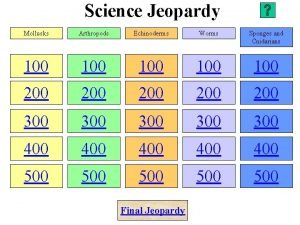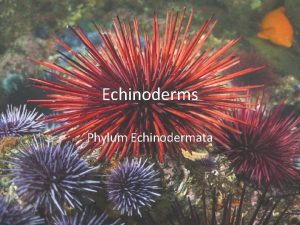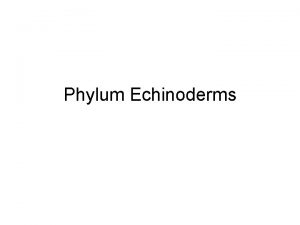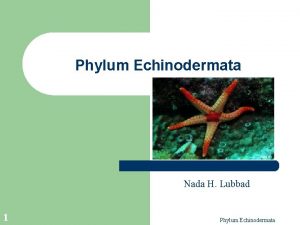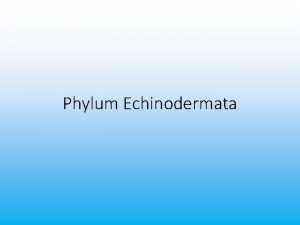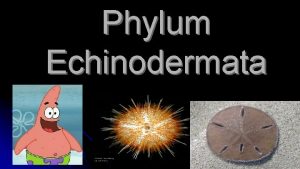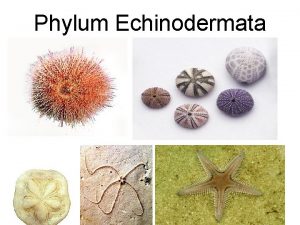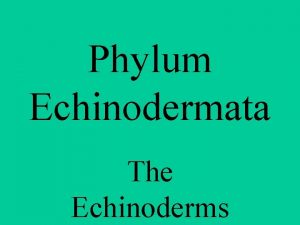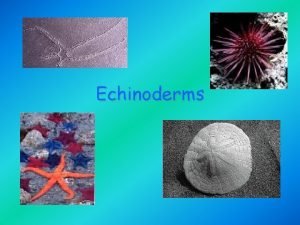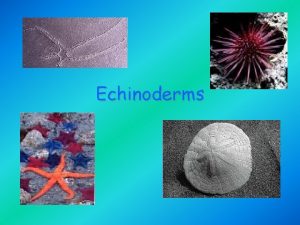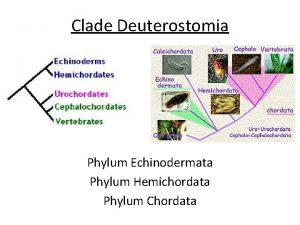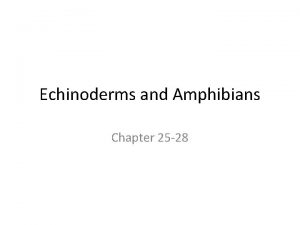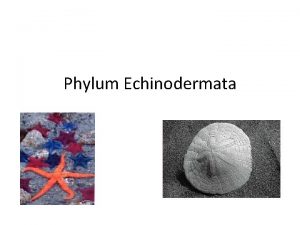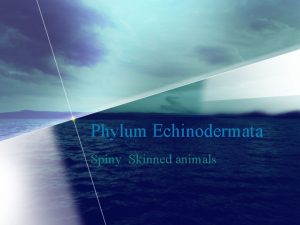Chapter 14 Echinoderms Characteristics of Phylum Echinodermata One






























- Slides: 30

Chapter 14, Echinoderms

Characteristics of Phylum Echinodermata One of the strangest and most unusual of all the phylums in the animal kingdom Echinoderms are deuterostomes, which they have in common with the chordates. All of the other invertebrates we learned about this semester have been protostomes No cephalization or brain or central nervous system, very few specialized sensory organs.

Characteristics of Echinoderms have a dermal endoskeleton made up of calcareous ossicles A water-vascular system that controls tenticlelike projections called podia or tube feet Development begins with a free-swimming, bilateral larva, and a metamorphosis into an adult with radial symmetry

Review of Animal Development and Symmetry

The Water-Vascular System Echinoderms have a unique system of canals and specialized tube feet that make up the water-vascular system The water-vascular system's primary function is for locomotion and for gathering food Additionally the water-vascular system also plays a role in respiration and excretion

The Water-Vascular System The water-vascular system enters the body through an opening called the madreporite. The madreporite leads to a canal called the stone canal. The stone canal leads to a ring around the mouth called the ring canal. The ring canal branches off into radial canals, and the radial canals branch off into lateral canals. The lateral canals lead to muscular sacs called ampullae, and the ampullae lead to the podia or tube feet

The Water-Vascular System

Class Asteroidea (Sea Stars) Sea stars or starfish typically have five arms which is called pentaradial symmetry Mouth is on the oral side. The side that is opposite of the mouth is the aboral side. Ambulacral grooves radiate out along the arms from the mouth located on the oral side Tube feet (also called podia) stick out from the ambulacral grooves Radial nerves run the length of the grooves

General Anatomy of an Echinoderm

Feeding and Digestive System Sea stars typically have two stomachs A larger and lower cardiac stomach and the smaller upper pyloric stomach Sea stars are opportunistic carnivores They feed upon molluscs, crustaceans, polychaetes, small fish, and other echinoderms They hunt by grabbing their prey with their tube feet. Then they evert their stomach (turn it inside out) and secrete digestive enzymes

Sea Star eating an Anchovy

Sea Star Reproduction Sexes are separate in most species Echinoderms can regenerate lost parts Sea stars can also deliberately detach part of their own bodies and cast off an arm near its base. A quality referred to as autotomy If a detached arm contains at least a fifth of the central disc (main body), the arm can regenerate an entirely new sea star

Sea Star Regeneration

Class Ophiuroidea (Brittle Stars) Arms of brittle stars are more slender than members of the class Asteroidea (sea stars) Tube feet are used for feeding, but not locomotion as in the sea stars Locomotion is by movement of their arms The madreporite is located on the oral surface, unlike the sea star's madreporite, which is located on the aboral surface Five movable plates on the oral surface that serve as jaws. They have no anus, so food that is not digested is expelled out the mouth

Brittle Stars

Class Ophiuroidea (Brittle Stars) Because the arms are so slender, all of the major organs are in the central disc (body) The water-vascular system and nervous system is very similar to the sea star's Reproduction is similar also. Sexes are usually separate, and regeneration and autotomy are common to the brittle stars

Brittle Stars

Class Echinoidea (Sea Urchins and Sand Dollars) Animals in class Echinoidea have a compact body or shell called a Test Echinoids lack arms, but their test is still divided into five parts like the sea star's and brittle star's Inside a sea urchin's test is a coiled digestive system and a complex chewing mechanism called Aristotle's lantern, which is used for chewing food, has teeth that are controlled by retractor and protractor muscles

Class Echinoidea (Sea Urchins and Sand Dollars) Sand Dollar Sea Urchin

Sea Urchin Anatomy

Aristotle’s Lantern

Class Holothuroidea (Sea Cucumbers) Sea cucumbers are elongate and have 10 -30 oral tentacles around the mouth that are modified tube feet Strangely, although there appears to be an anterior end, cephalization is absent Respiration occurs in a unique network of tubes and branches called the respiratory tree When threatened, sea cucumbers can discharge long sticky toxic substances called Cuvierian tubules

Sea Cucumbers

Sea Cucumber Anatomy

Cuvierian Tubules

Class Crinoidea (Sea Lilies and Feather Stars) Their bodies are attached to the ocean floor for at least part of their life The calyx (body) of a sea lily is attached to a stalk on the aboral side The stalk attaches to the ground surface Five flexible arms branch to form many more arms, each with many lateral pinnules arranged like barbs on a feather. Feather stars resemble sea lilies without a stalk

Sea Lily Anatomy

Feather Star

Echinoderms

Echinoderms
 Starfish
Starfish Echinodermata
Echinodermata Ampullae starfish
Ampullae starfish What phylum does squidward belong to
What phylum does squidward belong to Echinoderms facts
Echinoderms facts Class ophiuroidea characteristics
Class ophiuroidea characteristics Spines in echinoderms
Spines in echinoderms Characteristics of echinoderms
Characteristics of echinoderms Dermal ossicles
Dermal ossicles Echindermata
Echindermata Echinodermscharacteristics
Echinodermscharacteristics Horseshoe crab respires through lungs.
Horseshoe crab respires through lungs. Filum animalia
Filum animalia Sand dollar anatomy
Sand dollar anatomy Taxonomists have divided echinoderms into classes
Taxonomists have divided echinoderms into classes Ophiuroidea berkembang biak secara
Ophiuroidea berkembang biak secara Echinoderm body cavity
Echinoderm body cavity Struktur tubuh crinoidea
Struktur tubuh crinoidea Spiny skinned animals have an endoskeleton formed with
Spiny skinned animals have an endoskeleton formed with Economic importance of echinoderms
Economic importance of echinoderms Echinodermata germ layers
Echinodermata germ layers Phylum of cuttlefish
Phylum of cuttlefish Porifera sistema digestivo
Porifera sistema digestivo Calcareous endoskeleton
Calcareous endoskeleton Crinoidea
Crinoidea Holothuroidea examples
Holothuroidea examples Dueterostomes
Dueterostomes Sistem saraf echinodermata
Sistem saraf echinodermata Holothuroidea
Holothuroidea Echinoderm means spiny skin
Echinoderm means spiny skin Chapter 27 mollusks and segmented worms answer key
Chapter 27 mollusks and segmented worms answer key
